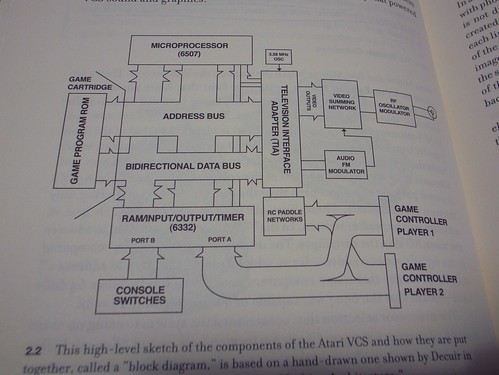 As part of our project about gamepad design evolution, we collect plenty of material concerning game interfaces (mostly joypad but still) and historical pointers about these devices. Which is why we've paid close attention to the recent "Platform Studies collection at MIT press, which "investigates the relationships between the hardware and software design of computing systems and the creative works produced on those systems".
As part of our project about gamepad design evolution, we collect plenty of material concerning game interfaces (mostly joypad but still) and historical pointers about these devices. Which is why we've paid close attention to the recent "Platform Studies collection at MIT press, which "investigates the relationships between the hardware and software design of computing systems and the creative works produced on those systems".
Although it does not deal with gamepad per se, the first book in this series is highly relevant to us. Called "Racing the Beam: The Atari Video Computer System", it's written by Nick Montfort & Ian Bogost. The point of this book is to show that the physical hardware design of the Atari VCS influenced the design of some games, and that those design decisions themselves gave birth to conventions still apparent in modern video game design. In terms of methodology, Montfort and Bogost details that their approach is "mainly informed by the history of material texts, programming, and computing systems".
The whole book was a great read (both from a personal and project-oriented perspective). The introductory chapter set the issues at stake and gave a good perspective on the decisions that lead to the Atari 2600. Each of the other chapter presents different cartridge-based games as case studies to highlight design issues (such as space scrolling for example). The descriptions are quite detailed, which makes the book a good reference. Some excerpts that I found important to my work:
About the importance of "platform studies", p.3
"Studies in computer science and engineering have addressed the question of how platforms are best developed and what is best encapsulated in the platform. Studies in digital media have addressed the cultural relevance of particular software that runs on platforms. But little work has been done on how the hardware and software of platforms influences, facilitates, or constrains particular forms of computational expression. (...) work that is built for a platform is supported and constrained by what the chosen platform can do. Sometimes the influence is obvious: a mono- chrome platform can’t display color, for instance, and a videogame console without a keyboard can’t accept typed input. But there are more subtle ways that platforms influence creative production, due to the idioms of programming that a language supports or due to transistor-level deci- sions made in video and audio hardware. (...) platforms also function in more subtle ways to encourage and discourage different sorts of computer expression."
This is important for our project because we want to observe a different sort of platform: the gamepad, how it has been created (based on earlier lineage such as joysticks), how it evolved and what is the relationship between the joypad hardware and game control schemes.
The design of the Atari VCS itself is based on a different set of decisions that are grounded in earlier platforms, as shown on p.11 and 12:
"The tremendous success of Pong and the home Pong units suggested that Atari should produce a machine capable of playing many games that were similar to Pong. The additional success of Tank by Kee Games suggested another similar game (...) along with projectiles that bounced off walls. The computational model and basic game form were almost identical to those of Pong, and became the essence of Combat, the title that was included with the original VCS package. The simple elements present in these early games would be the basis for the console’s capabilities from that point on. (...) The engineers developing the Atari VCS needed to account for two goals— the ability to imitate existing successful games and some amount of versatility —as they designed the circuitry for a special-purpose microcomputer for video games (...) Material factors certainly influenced the design. (...) The Atari VCS would need to navigate between the Scylla of powerful but expensive processors and the Charybdis of a cut-rate but inflexible set of hardwired games."
The part about controllers is of course relevant for our project, p.22-23:
"although joysticks were already in use in arcades by 1977, the introduction of the VCS joystick into the context of the home undoubtedly did much popularize the controller (...) the game joysticks are connected by cords to the console, where they are plugged in. This means that they can be unplugged and different controllers can be swapped in for different games: it also means that players can sit back away from the video-game unit as they play" (...) "there arose the issue in the difference between the controller scheme of the inspirational arcade game and the available VCS controllers. The VCS controllers were simpler than those in many contemporary arcade games. Although it was possible to develop new controller, the cost and difficulty of doing so precluded it in almost every case. It also wasn't tenable to produce arcade-style controls of greater durability, higher quality, and higher cost for the home market."

About the "lineage" and path-dependence between the VCS games and recent games, p.5:
"Gradually, conventions of different sorts began to emerge and various genres became evident. Some of the development of today’s videogame genres arose thanks to computer games and arcade games, but games for the Atari VCS made important contributions as well. (...) In studying the Atari VCS from the perspective of the platform, several things stand out about the system and its influence on the future of video games.
- The strong relationship between the console and the television. (...) The focus on the production of images for display on the TV helps explain why games running on circuits and later computers became known as “video games,
- Its controllers and peripherals were fashioned for use on the floor or the couch. The games made for the platform are likewise oriented toward home use—either for enjoying the arcade experience at home or for playing in different ways with friends and family.
- The powerful influence of earlier games.
- The tremendous representational flexibility of the machine and the less-than-obvious reason for this flexibility. (...) The breadth of the system’s software library becomes even more striking when one considers that two simple arcade games were the major inspirations for its hardware design—and that no one fathomed how successful and long-lived the console would be."
Why do I blog this? The "platform studies" rationale seems to be an interesting approach for our gamepad project. We'll try to ground our discussion in such type of work, although we do not know yet whether ours should be as academic as this piece.

